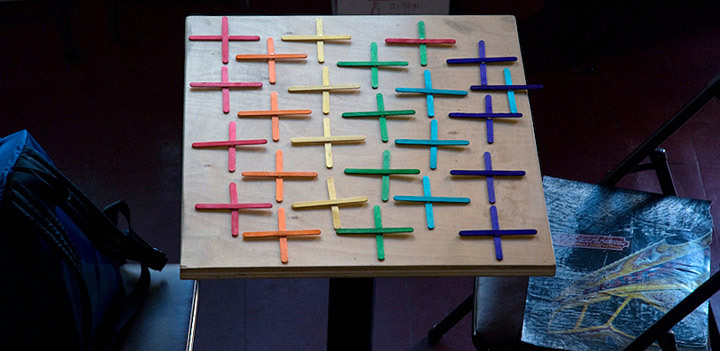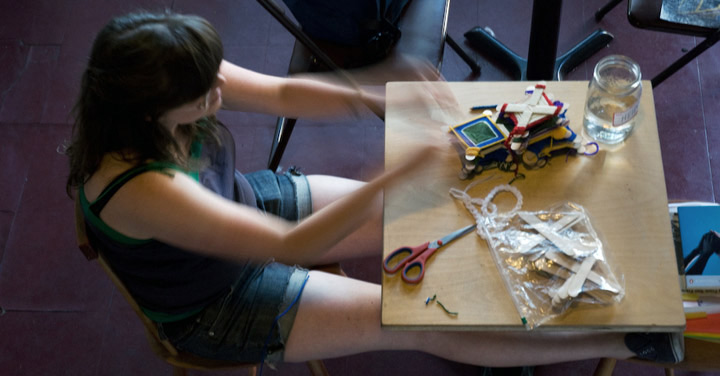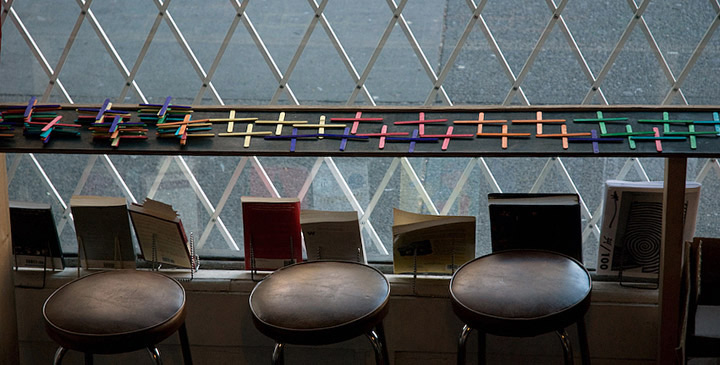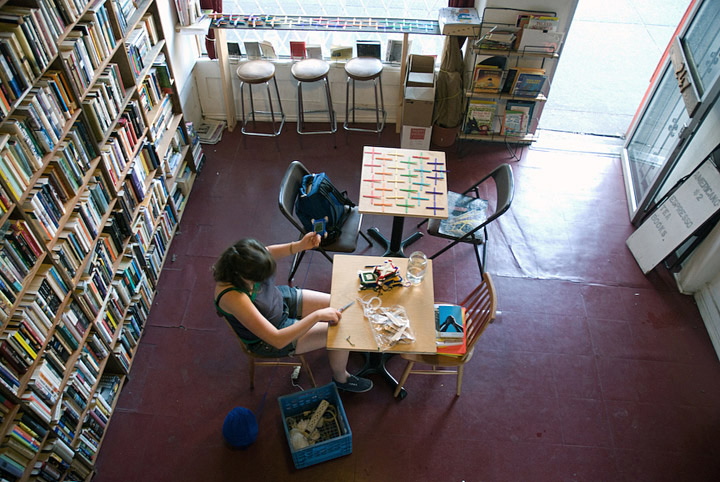| interviews | the writting on the wall | murals |
Colleen Heslin Interviews Heidi Nagtegaal, Summer/Fall 2009 |
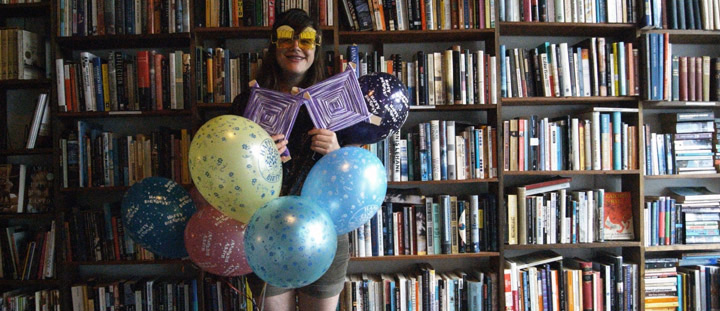 |
Colleen Heslin: Hi Heidi, how are you? I know that you just got your braces removed so it's a bit of a beginning of a new era for you. Heidi Nagtegaal: Hi Colleen, I'm doing fantastic. Really great. Just got in the studio, working on some projects, feeling happy. I love being Brace Free. Before I got them taken off, Leah Benetti did a photo shoot with me; we were looking to get some shots with sunlight bouncing off my braces. It's the end of an era. CH: Your work has a magical way of situating itself in contemporary art, but it also has folk and craft roots. Where does your impulse towards craft come from? HN: Thanks for the compliment! I draw from contemporary, folk and craft roots for sure, and I'm glad that comes across. I'm also very interested in magic, and how things can be magical, and beautiful. I want to take you somewhere; I want to take you for a ride; hit you where it counts. I started using crafts because I was drawn to the straightforwardness of it all. There is no mystery in it, in the sense that you can get craft patterns at the store, and everyone's seen somebody knit, or crotchet. It's obvious. I want it to be approachable, and crafts are extremely approachable CH: I like the way you just flipped the word "magical" from a context to a qualitative part of the work - specifically with the headband happenings that you inject into various social situations. I used to think about magic in my work, I guess more so when working collaboratively. Back in Art School in the 90’s I had to make a 16mm film and I felt a bit lost and unorganized but at the last minute everyone came together and got what I wanted. People described it as magical and I felt so lucky. The nice thing about magic is that it either happens or it doesn't, you can't try to create it, and sometimes if you over think or plan you can kill it. Tell me about your knitting and headband happenings - what do you think about when you’re making them? HN: The magic is just being part of the process. The magic is the lived experience, the here and now. When I'm making the Headbands, I'm thinking about you, the recipient, and participant. I have no idea if you will like it or not, be into it, or not, receive it or throw it on the floor. The only thing I know is that I am going to give it to you and you are going to respond however you will. There's such honesty in that. To me, I can't do things if they're not honest. I'm kind of over the top that way; I always need to be straight up. My process and my art is like that too. With the Headbands, I can't control you, I'm not Headbanding an Event to do something to it - there are no preconceived notions. I'm not making them thinking people will love them. I have no idea what will happen! I make them to give them, and however they are received, they're received. Even in rejection, there is a receiving because you are at least acknowledging the object. It’s a collaboration, you can’t control it; there’s no point.
CH: But do you hope for love, excitement, and embracement? I know that I can catch myself feeling this way, and not just about my work, but I think it's a natural way to feel and strive for socially. I agree I would say love first, and then rejection, and indifference can be the biggest sting - silent treatment. HN: Oh yeah, everyone wants the love, it's natural, it's universal. We all want to love and be loved, it's basic. I would love to be part of a big, social, love in with the Headband piece, but it's not that way. When you give people a Headband with the expectation that everyone's going to love it and feel all groovy (or whatever) and have this cosmic social experience, that's a lot of pressure and then the project (the Headbands, in this case) has no room to become it's own thing. It's important to me that my art has room to breathe, to have eyes, ears, senses of their own, beyond my intentions for them. I make the Headbands, and I give them away. There are no rules for engagement, or expectations. But yeah - I really want people to be excited about my practice, with me. I'm totally dedicated to my practice, and my biggest joy is to share it. I think this is something that all artists share - we don't just log in countless hours in our studios making things to not show them. Even if we're really shy, we may suck at showing them, but we still want them. I have repetitive stress in my right arm from crocheting; I have a calcium deposit in my left hand from finger knitting. I don't do this because I love pain or pushing myself too far. I do this because I am excited about what I do and I want to get it out there. No one else is going to make Headbands for people or invite people over to a Hammock Residency, make a Bad Energy Trap or make a full body suit and hug people in shopping districts. If I want to see that happen, I have to do it. I have to put it out there. And I'm really stoked about putting it out there; and when you get into it with me, it's a beautiful thing. Because, yeah, when I make art, when I make Headbands or update the websites or hole up in my room for 10 hours knitting Smoke Rings, I'm thinking about you, or the potential you, the future.
CH: The HAMMOCK RESIDENCY! That came up in one of our first conversations. You were familiar with The Crying Room, a space that I have used over the last 10 years in Vancouver to show emerging artists work, and you told me about your Hammock Residency a space that you give out to artists to think about their practice, and sometimes this leads to collaborative projects. What have you got going on at the Hammock Residency right now? HN: Well, it's an exciting time for the Hammock Residency, for me, especially. Joomi Seo was in for July & August 2009 and it was incredible. She's an amazing artist, extremely multi disciplinary, poetic and talented. And humble. You'll never hear her toot her own horn. At least, I haven't. She stayed over at my house when one of my roommates (Phoebe Jin) went on holidays for May/June, and her and I had this habit of staying up all night, talking about art, life, peace & poetry. And music. Joomi is heavy into music. She proposed to stay in the Hammock for July, and work on a music project with me, based on all our late night conversations and jam outs. It ended up turning into a July/August residency based on Solder & Sons and the rad man who is Robert Pedersen. This is where YOU come in, Colleen, because that’s how we began to hang out! Solder & Suns, Summer 2009. CH: Yeah, tell us about Solder & Suns and how you ended up hanging out there, and doing the Hammock Residency there this summer. HN: Okay, so I go into Solder & Sons to talk to Robert Pedersen about music, because he has music shows at S&S, and we just vibed. He ended up offering me the space after hours as a music & writing studio (which I had been wanting, and didn't even realize it) in exchange for a one day a week shift - Mondays, 10-4. Joomi and I started jamming in Solder & Sons, and I started taking poetry more seriously, at Joomi's prodding. The Hammock Residency works both ways, when the artist is really engaged. I was just thinking of hearing Joomi write more music, but then she loved jamming with me, so that happened, and it's magical. Through that, I ended up writing more, and sharing my process with Joomi, and Joomi sharing her process with me. Robert Pedersen knew that Joomi and I needed a space to jam out, so he opened the doors for us to use S&S. It’s been an amazing summer. (For those of you who don't know anything about the Hammock Residency and this is way over your head, the Hammock Residency is a residency I have at my house where people can stay and work on their projects, or think about their projects, or do whatever it is they need to do to get from A to B. If they want, they can talk with me, and hang out, but if they want to be alone, that's cool too. You don't actually live in the Hammock, most times, but I have a key and you just call me up and let me know you're coming, etc. You can check it out on the web: http://www.hammockresidency.com) CH: The Hammock Residency is a unique concept. It has this DIY vibe, but it also seems to reflect types of institutionalized creative spaces with a similar function, to connect you with other artist and spaces and legitimize or validate your work and ideas. The Hammock Residency seems to me a funny play on that, where you think, instead of research and work - what gave you the idea to start the Hammock Residency? HN: The Hammock Residency started off because when people came over to my house they would often say stuff like they wanted to stay here and make stuff, because it had this productive, creative energy going on. When people were in town, they would stay in my studio and comment on that too, so it kind of started there. Just being in someone else's studio gets you thinking about your studio practice, and can spin things in a different way. So that's rad. I definitely know the feeling of being in someone else's studio and getting amped off of their practice and then wanting to bring that amp into your practice. Sharing excitement with other people is a natural collaboration. All of a sudden it moves from talking to doing to action, shows, new concepts, exhibits, random shit, because you’re excited. Focus and productivity, it goes hand in hand with excitement. When you’re excited about something, you get the stoke going, can’t stop thinking about things and this sense of urgency builds. It’s not an option just to think about it anymore, you have to DO something. When you get a collaboration going, it’s much easier to do things sometimes, because you’ve got someone in your corner, someone to keep you stoked and focused. Remind you what awesome is. Tag team.
CH: That was going to be the second part of that question - productive socializing and you got there on your own. My studio is around the corner from where you're doing the residency at S & S, I usually go there for coffee and end up losing studio time to social time, but you have a great way of keeping things in action. Most of my friends who get into studio mode need to be alone to focus, and I usually fall into that camp. I was never a social sketcher I like to draw alone, and I shy away from collaborations at times because it is a fine balance of labor and organization and sometimes heavy on the talk with a lack of action - but here we are collaborating with yarn and paint sticks. How do you keep it going? HN: I love people. I am endlessly curious & I have a lot of energy. I log in a lot of time in my studio, but I love people too. I'm a half alone, half with people person. I can be in my studio and not even realize it's 4am and the sky is pink outside. Then I have to get up for work at 6. Super intense, but totally worth it, because you need to keep on doing what you love. Apart from loving making work, I love being with people too. I'm a really creative person and love making things happen, even if it's as simple as throwing a potluck or making my friends some cool doo-dad. I want to make you smile. Because when you smile, I smile too. I just can't help it. I don't make things to feel good; it just feels good to be nice. It feels good to do stuff for other people, not because you have to, but because you can. All that just turns into one big mash of social - introverted energy. When I make art objects and spend zillions (literally) of hours in the studio, at the end, you get to interact with my work in the gallery. If it's a socially oriented piece, like the Headbands and Bracelets or Hammock Residency, the social part is there from the get go. But there's all kinds of admin stuff too that HBAB and the HR take too. It's not all social. Managing the website and making the Headbands take more hours than I can count. So yeah, I'm social, but I'm also introverted. There's lots of alone time in my practice, but also a lot of collabo-social time. It also helps that I am super persistent and motivated, and as Robert said when he first met me "I have a fire that won't go out." Which was really nice of him. It's true though, that resonates with me. I really believe in DIY. When there isn't a way that you can take, you can always make your own way. At the end of the day, if you don't do it, it's just going to be an idea. I'm really into the thinking AND the doing. It takes both for me to be satisfied. I can't just think about stuff, I have to do it. If I really believe in something, I will be moved into action. Which means I have a lot of thoughts, but the things I do, I am really committed to, they have my intention completely. I've made the decision, I've chosen the path, and I'm going to try my best to follow through. Even if things totally don't work out, at least you tried. You're always going to learn from something, even if you "lose out" you'll always win in the end with some sort of neat life lesson, or things to do different next time. CH: Lots of positivity here. One thing we haven’t talked about before we wrap this up is moustaches and beards. That was my first introduction to your work was the crocheted beards and mustaches at the Richmond Art Gallery this year with Kristi Malakoff, it was one of my favorite shows this year. It was a great paring, her work is often highly detailed in an awe-inspiring way, how was it like showing together? HN: Kristi Malakoff is fantastic. She’s such a hustler, gets things going, doesn’t take no for an answer, spends all day installing stuff, doesn’t eat, doesn’t sleep, runs off steam and makes amazing art work. All her energy goes right into the work. She’s incredible to work with because you get 300% of her. Carie Helm curated Guise and didn’t even know that Kristi and I knew each other, have shown together, worked together and graduated together! She just liked both of us individually and loved how hard-core we both were about placing crafts in a contemporary context. The Facial Hair Study came about because I was obsessed with Facial Hair and how I could never grow it. It’s something that I can’t do, so I crocheted facial hairpieces for myself. They were based on famous, seen or imagined beards and moustaches, out of yarn that I had salvaged and then color-matched to official Colour Theory Charts. It got way out of control. There were 7 different series: Metallic, Iridescent, Pearl, Neutral, Radiant, Fluorescent and Full Spectrum and 70 Facial Hair Pieces. Each Facial Hair piece matches up with a name/date/type/colour/series – it’s all organized, an archive of identity, collective identity and male identity. For example, I made Raymond Boisjoly, Summer 2009, Full Beard, Yellow Ochre, Metallic Series; Charlie Chaplin, 1915, Toothbrush, Light Gold, Metallic Series. 2009
|
| previous | interviews |
